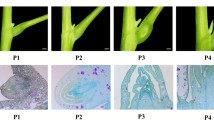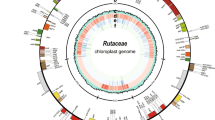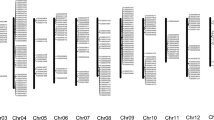Abstract
To investigate the homeotic systems underlying floral development in a dioecious tree, and to provide tools for the manipulation of floral development, we have isolated two Populus trichocarpa genes, PTAG1 and PTAG2, homologous to the Arabidopsis floral homeotic gene AGAMOUS (AG). PTAG1 and PTAG2 are located on separate linkage groups, but their non-coding regions are highly similar, consistent with a phylogenetically recent duplication. Intron/exon structure is conserved in relation to AG and the Antirrhinum AG orthologue, PLENA (PLE), and low-stringency Southern analysis demonstrated the absence of additional genes in the poplar genome with significant PTAG1/2 homology. PTAG1 and PTAG2 exhibit an AG-like floral expression pattern, and phylogenetic analysis of the AG subfamily strongly supports evolutionary orthology to C-class organ identity genes. The high degree of similarity shared by PTAG1 and PTAG2 in both sequence (89% amino acid identity) and expression indicates that they are unlikely to be functionally associated with specification of tree gender. Unexpectedly, PTAG transcripts were consistently detected in vegetative tissues.
Similar content being viewed by others
References
Ainsworth, C., Crossley, S., Buchanan-Wollaston, V., Thangavelu, M. and Parker, J., 1995. Male and female flowers of the dioecious plant sorrel show different patterns of MADS-box gene expression. Plant Cell 7: 1583–1598.
Alstrom-Rapaport, C., Lascoux, M. and Gullberg, U., 1997. Sex determination and sex ratio in the dioecious shrub, Salix viminalis L. Theor. Appl. Genet. 94: 493–497.
Alstrom-Rapaport, C., Lascoux, M., Wang, Y.C., Roberts, G. and Tuskan, G.A., 1998. Identification of a RAPD marker linked to sex determination in the basket willow (Salix viminalis L.). J. Hered. 89: 44–49.
Angenent, G.C., Franken, J., Busscher, M., van Dijken, A., van Went, J.L., Dons, H.J.M. and van Tunen, A.J., 1995. A novel class of MADS box genes is involved in ovule development in petunia. Plant Cell 7: 1569–1582.
Boes, T.K. and Strauss, S.H., 1994. Floral phenology and morphology of black cottonwood, Populus trichocarpa (Salicaceae). Am. J. Bot. 81:5 62–567.
Bowman, J.L., Drews, G.N. and Meyerowitz, E.M., 1991. Expression of the Arabidopsis floral homeotic gene AGAMOUS is restricted to specific cell types late in flower development. Plant Cell 3: 749–758.
Bradley, D., Carpenter, R., Sommer, H., Hartley, N. and Coen, E., 1993. Complementary floral homeotic phenotypes result from opposite orientations of a transposon at the plena locus of Antirrhinum. Cell 72: 85–95.
Bradshaw, H.D. Jr., 1998. Case history in genetics of long-lived plants: molecular approaches to domestication of a fast-growing forest tree: Populus. In: A.H. Paterson (Ed.) Molecular Dissection of Complex Traits, CRC Press, Boca Raton, FL, pp. 219–228.
Bradshaw, H.D. Jr., Villar, M., Watson, B.D., Otto, K.G., Stewart, S. and Stettler, R.F., 1994. Molecular genetics of growth and development in Populus III. A genetic linkage map of a hybrid poplar composed of RFLP, STS, and RAPD markers. Theor. Appl. Genet. 89: 167–178.
Busch, M.A., Bomblies, K. and Weigel, D., 1999. Activation of a floral homeotic gene in Arabidopsis. Science 285: 585–587.
Colombo, L., Franken, J., Koetje, E., van Went, J., Dons, H.J.M., Angenent, G.C. and van Tunen, A.J., 1995. The petunia MADS box gene FBP11 determines ovule identity. Plant Cell 7: 1859–1868.
Crepet, W.L. and Feldman, G.D., 1991. The earliest remains of grasses in the fossil record. Am. J. Bot. 78: 1010–1014.
Davies, B., Motte, P., Keck, E., Saedler, H., Sommer, H. and Schwarz-Sommer, Z., 1999. PLENA and FARINELLI: redundancy and regulatory interactions between two Antirrhinum MADS-box factors controlling flower development. EMBO J. 18: 4023–4034.
D'Ovidio, R., Mugnozza, G.S. and Tansarella, O.A., 1991. rDNA cloning and rapid hybrid identification in the Populus spp. (Salicaceae). Plant Syst. Evol. 177: 165–174.
Doyle, J.J., 1994. Evolution of a plant homeotic multigene family: toward connecting molecular systematics and molecular developmental genetics. Syst. Biol. 43: 307–328.
Eckenwalder, J.E., 1996. Systematics and evolution of Populus. In: R.F. Stettler, H.D. Bradshaw, Jr., P.E. Heilman and T.M. Hinckley (Eds.) Biology of Populus and its Implications for Management and Conservation, Part I, Chapter 1, NRC Research Press, National Research Council of Canada, Ottawa, pp. 7–32.
Filipecki, M.K., Sommer, H. and Malepszy, S., 1997. The MADSbox gene CUS1 is expressed during cucumber somatic embryogenesis. Plant Sci. 125: 63–74.
Goodrich, J., Puangsomlee, P., Martin, M., Long, D., Meyerowitz, E.M. and Coupland, G., 1997. A polycomb-group gene regulates homeotic gene expression in Arabidopsis. Nature 386: 44–51.
Hillis, D.M., Mable, B.K. and Moritz, C., 1996. Applications of Molecular Systematics. In: D.M. Hillis, C. Moritz, and B.K. Mable (Eds.) Molecular Systematics, 2nd ed., Sinauer Associates, Sunderland, MA, pp. 515–543.
Hughes. D.W. and Galau, G., 1988. Preparation of RNA from cotton leaves and pollen. Plant Mol. Biol. Rep. 6: 253–257.
Irish, V.F. and Kramer, E.M., 1998. Genetic and molecular analysis of angiosperm flower development. In: J.A. Callow (Ed.) Advances in Botanical Research, Vol. 28, Academic Press, San Diego, CA, pp. 197–230.
Kater, M.M., Colombo, L., Franken, J., Busscher, M., Masiero, S., van Lookeren Campagne, M.M. and Angenent, G.C., 1998. Multiple AGAMOUS homologs from cucumber and petunia dif634 fer in their ability to induce reproductive organ fate. Plant Cell 10: 171–182.
Kaul, R.B., 1995. Reproductive structure and organogenesis in a cottonwood, Populus deltoides (Salicaceae). Int. J. Plant Sci. 156: 172–180.
Kelly, A.J., Bonnlander, M. and Meeks-Wagner, D.R., 1995. NFL, the tobacco homolog of FLORICAULA and LEAFY, is transcriptionally expressed in both vegetative and floral meristems. Plant Cell 7: 225–234.
Kim, Y.-S., Lee, H.-S., Lee, M.-H., Yoo, O.-J. and Liu, J.-R., 1998. A MADS box gene homologous to AG is expressed in seedlings as well as in flowers of ginseng. Plant Cell Physiol. 39: 836–845.
Kumar, S, Tamura, K. and Nei, M., 1993. MEGA: Molecular Evolutionary Genetic Analysis, version 1.0. Pennsylvania State University, University Park, PA
Lincoln, S., Daly, M. and E. Lander, 1992. Constructing genetic maps with MAPMAKER/EXP 3.0. Whitehead Institute Technical Report, 3rd ed.
Ma, H., Yanofsky, M.F. and Meyerowitz, E.M., 1991. AGL1–AGL6, an Arabidopsis gene family with similarity to floral homeotic and transcription factor genes. Genes Dev. 5: 484–495.
Masterson, J., 1994. Stomatal size in fossil plants: evidence for polyploidy in majority of angiosperms. Science 264: 421–424.
McLetchie, D.N. and G.A. Tuskan, 1994. Gender determination in Populus. Norw. J Agric. Sci. Suppl. 18: 57–66
Mena, M., Ambrose, B.A., Meely, R.B., Briggs, S.P., Yanofsky, M.F. and Schmidt, R.J., 1996. Diversification of C-function activity in maize flower development. Science 274: 1537–1540.
Mizukami, Y. and Ma, H., 1995. Separation of AG function in floral meristem determinacy from that in reproductive organ identity by expressing antisense AG RNA. Plant Mol. Biol. 28: 767–784.
Mizukami, Y. and Ma, H., 1997. Determination of Arabidopsis floral meristem identity by AGAMOUS. Plant Cell 9: 393–408.
Münster, T., Pahnke, J., Di Rosa, A., Kim, J.T., Martin, W., Saedler, H. and Theissen, G., 1997. Floral homeotic genes were recruited from homologous MADS-box genes preexisting in the common ancestor of ferns and seed plants. Proc. Natl. Acad. Sci. USA 94: 2415–2420.
Muse, S.V., 1996. Estimating synonymous and nonsynonymous substitution rates. Mol. Biol. Evol. 13: 105–114.
Nei, M. and Gojobori, T., 1986. Simple methods for estimating the numbers of synonymous and nonsynonymous nucleotide substitutions. Mol. Biol. Evol. 3: 418–426.
Purugganan, M.D., 1997. The MADS-box floral homeotic gene lineages predate the origin of seed plants: phylogenetic and molecular clock estimates. J. Mol. Evol. 45: 392–396.
Purugganan, M.D., Rounsley, S.D., Schmidt, R.J. and Yanofsky, M.F., 1995. Molecular evolution of flower development: diversi-fication of the plant MADS-box regulatory gene family. Genetics 140: 345–356.
Riechmann, J.L. and Meyerowitz, E.M., 1998. MADS domain proteins in plant development. Biol. Chem. 373: 1079–1101.
Rigola, D., Pe, M.E., Fabrizio, C., Me, G. and Sari-Gorla, M., 1998. CaMADS1, a MADS box gene expressed in the carpel of hazelnut. Plant Mol. Biol. 38: 1147–1160.
Rounsley, S.D., Ditta, G.S. and Yanofsky, M.F., 1995. Diverse roles for MADS box genes in Arabidopsis development. Plant Cell 7: 1259–1269.
Rutledge, R., Regan, S., Nicolas, O., Fobert, P., Cote, C., Bosnich, W., Kauffeldt, C., Sunohara, G., Seguin, A. and Stewart, D., 1998. Characterization of an AGAMOUS homologue from the conifer black spruce (Picea mariana) that produces floral homeotic conversions when expressed in Arabidopsis. Plant J. 15: 625–634.
Saitou, N. and Nei, M., 1987. The neighbor-joining method: a new method for reconstructing phylogenetic trees. Mol. Biol. Evol. 4: 406–425
Savard, L., Li, P., Strauss, S.H., Chase, M.W., Michaud, M. and Bousquet, J., 1994. Chloroplast and nuclear gene sequences indicate Late Pennsylvanian time for the last common ancestor of extant seed plants. Proc. Natl. Acad. Sci. USA 91: 5163–5167.
Savidge, B., Rounsley, S.D. and Yanofsky, M.F., 1995. Temporal relationship between the transcription of two Arabidopsis MADS box genes and the floral organ identity genes. Plant Cell 7: 721–733.
Sieburth, L.E. and Meyerowitz, E.M., 1997. Molecular dissection of the AGAMOUS control region shows that cis elements for spatial regulation are located intragenically. Plant Cell 9: 355–365.
Snedecor, G.W. and Cochran, W.G., 1989. Statistical Methods, 8th ed. Iowa State University Press, Ames, IA.
Soltis, P.S., Soltis, D.E. and Chase, M.W., 1999. Angiosperm phylogeny inferred from multiple genes as a tool for comparative biology. Nature 402: 402–403.
SYSTAT, 1998. SYSTAT for Windows: Statistics, Version 8.0. SPSS.
Tajima, F. and Nei, M., 1984. Estimation of evolutionary distance between nucleotide sequences. Mol. Evol. Biol. 1: 269–285.
Tandre, K., Svenson, M., Svenson, M.E. and Engstrom, P., 1998. Conservation of gene structure and activity in the regulations of reproductive organ development of conifers and angiosperms. Plant J. 15: 615–623.
Theissen, G., Strater, T., Fischer, A. and Saedler, H., 1995. Structural characterization, chromosomal localization and phylogenetic evaluation of two pairs of AGAMOUS-like MADS-box genes from maize. Gene 156: 155–166.
Thompson, J.D., Higgins, D.G. and Gibson, T.J., 1994. CLUSTAL W: improving the sensitivity of progressive multiple sequence alignment through sequence weighting, position-specific gap penalties and weight matrix choice. Nucl. Acids Res. 22: 4673–4680.
Tsuchimoto, S., van der Krol, A.R. and Chua, N.-H., 1993. Ectopic expression of PMADS3 in transgenic petunia phenocopies the petunia blind mutant. Plant Cell 5: 843–853.
Wolfe, K.H., Gouy, M., Yang, Y.W., Sharp, P.M. and Li, W.H., 1989. Date of the monocot-dicot divergence estimated from chloroplast DNA sequence data. Proc. Natl. Acad. Sci. USA 86: 6201–6205.
Winter, K.-U., Becker, A., Münster, T, Kim, J.T., Saedler, H. and Theissen, G., 1999. MADS-box genes reveal that gnetophytes are more closely related to conifers than to flowering plants. Proc. Natl. Acad. Sci. USA 96: 7342–7347.
Yu, D., Kotilainen, M., Pollanen, E., Mehto, M., Elomaa, P., Helariutta, Y., Albert, V.A. and Teeri, T.H., 1999. Organ identity genes and modified patterns of flower development in Gerbera hybridia (Asteraceae) Plant J. 17: 51–62.
Author information
Authors and Affiliations
Rights and permissions
About this article
Cite this article
Brunner, A.M., Rottmann, W.H., Sheppard, L.A. et al. Structure and expression of duplicate AGAMOUS orthologues in poplar. Plant Mol Biol 44, 619–634 (2000). https://doi.org/10.1023/A:1026550205851
Issue Date:
DOI: https://doi.org/10.1023/A:1026550205851




